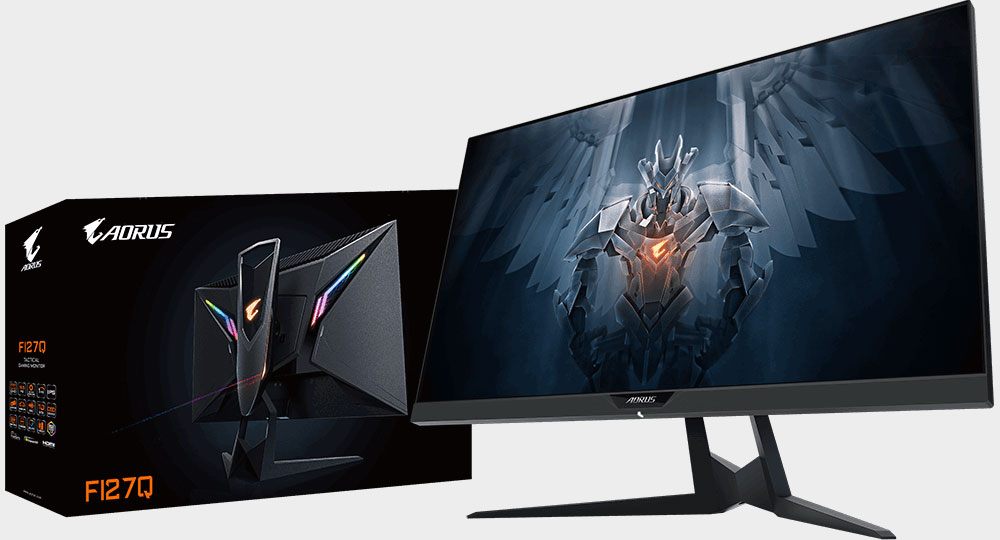Gigabyte launches another 27-inch 'tactical' IPS gaming monitor for $550
The new Aorus FI27Q can plop a crosshair into games that don't already have one.

For the second time, Gigabyte has rolled out the "world's first tactical monitor." And so I guess also for the second time, I'm writing about it for the first time.
Don't try wrapping your head around any of that, it will make your brain hurt. The bigger point is, Gigabyte's Aorus FI27Q is actually a new product, with slightly different specifications than the Aorus CV27Q.
Both are pitched as tactical 27-inch displays, each with a 2560x1440 resolution, but the FI27Q swaps out the curved VA panel on the CV27Q and replaces it with a flat IPS screen. IPS displays typically offer better color accuracy, though the difference is usually less pronounced than when comparing against a TN display.
Here's a rundown of the F127Q's specs:
- Panel size—27 inches
- Panel type—IPS, 10-bit (8 bits + FRC)
- Resolution—2560x1440 (1440p)
- Color saturation—95 percent of DCI-P3
- Brightness—350 nits
- Contrast ratio—1,000:1 typical, 12,000,000:1 dynamic
- Viewing angles—178 degrees (vertical/horizontal)
- Response time—1ms (MPRT)
- Refresh rate—165Hz
- Inputs—HDMI 2.0 (x2), DisplayPort 1.2 (x1), 3.5mm audio (x2), USB 3.0 (x2)
Compared to the CV27Q, the FI27Q offers a higher color saturation (95 percent versus 90 percent), lower brightness (350 nits versus 400 nits), and lower contrast ratio (1,000:1 versus 3,000:1).
This is a FreeSync display, and it's also G-Sync Compatible, meaning it's been validated to leverage Nvidia's G-Sync technology and is enabled by default (when paired with a compatible graphics card). Some non-certified FreeSync displays can run G-Sync as well, but if they are not officially compatible, then users have to enable the feature manually in the GeForce Control Panel and hope it works out.
Gigabyte's tactical branding is based on a set of amenities, including both common and not-so-common ones. Falling into the former category is a black level equalizer to enhance darker scenes. Other aspects of the tactical branding include:
Keep up to date with the most important stories and the best deals, as picked by the PC Gamer team.
- Aim stabilizer—reduces motion blur introduced by some games during certain situations, as might happen from the recoil of firing a shot.
- Aorus dashboard—shows system vitals (CPU and GPU frequencies, CPU and GPU fan speeds, CPU and GPU usage, GPU temp, and mouse dpi).
- GameAssist—lets you create custom crosshairs, adds an onscreen timer, and adds a gaming counter to "calculate the opponent's user of props or any count information."
- OSD Sidekick—set the OSD controls using your mouse and keyboard.
There's also noise cancelling technology with dual microphones to stifle background noises when chatting.
Gigabyte says the FI27Q supports HDR visuals. I'm not confident it would excel in that area, given the 350 nits brightness rating. I asked Gigabyte if it gets any higher when processing HDR content, and was told it peaks at 408 nits. For reference, 400 nits is one of the minimum requirements for VESA's DisplayHDR 400 certification (this is not a DisplayHDR-certified display).
I haven't tested this monitor, but I'm also not swayed by the tactical features. Fortunately, the specs look pretty good overall (save for HDR). It's also worth noting that this carries a zero bright dot guarantee for the first year.
It's priced a bit high, though. The FI27Q carries a $549.99 MSRP, and is already marked down to $519.99 on Amazon and Newegg. That's still expensive. The CV27Q, for example, currently sells for $419.99, while something like MSI's Optix MAG272QR goes for $349.99.
Paul has been playing PC games and raking his knuckles on computer hardware since the Commodore 64. He does not have any tattoos, but thinks it would be cool to get one that reads LOAD"*",8,1. In his off time, he rides motorcycles and wrestles alligators (only one of those is true).


